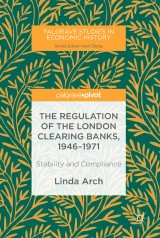Details

The Regulation of the London Clearing Banks, 1946-1971
Stability and CompliancePalgrave Studies in Economic History
|
53,49 € |
|
| Verlag: | Palgrave Pivot |
| Format: | |
| Veröffentl.: | 02.11.2018 |
| ISBN/EAN: | 9783030009106 |
| Sprache: | englisch |
Dieses eBook enthält ein Wasserzeichen.
Beschreibungen
<div><p>This book explores the way in which banks were regulated in the UK in the period from 1946 until 1971. It focuses upon a group of 11 banks known as the London clearing banks. These banks included the ‘Big Five’ – Barclays, Lloyds, Midland, National Provincial and Westminster – and were the equivalent to today’s retail banks.</p><p>The time period in question is an intriguing one in the history of banking and bank regulation in that the banking system was very stable, but the regulatory framework was less dependent upon codified forms of regulation than it is today. Having explored the nature of clearing bank regulation, Arch goes on to consider the rationale behind it, as well as its consequences. She concludes by reflecting upon the nature of bank regulation since the global financial crisis. This title is essential reading for academics with an interest in banking history and bank regulation, for practicing bank regulators and for regulatory policymakers.</p></div>
Chapter 1: Introduction.- Chapter 2: The Nature of Clearing Bank Regulation.- Chapter 3: Context, rationale and consequences.- Chapter 4: Bank Regulation Today.- Chapter 5: Conclusion.
<div><p><b>Linda Arch</b> is Lecturer in Finance at the ICMA Centre at Henley Business School, University of Reading, UK. She previously worked as a chartered management accountant and is Fellow of the Chartered Institute of Management Accountants, UK.</p><br></div>
<p>This book explores the way in which banks were regulated in the UK in the period from 1946 until 1971. It focuses upon a group of 11 banks known as the London clearing banks. These banks included the ‘Big Five’ – Barclays, Lloyds, Midland, National Provincial and Westminster – and were the equivalent to today’s retail banks.</p>
<p>The time period in question is an intriguing one in the history of banking and bank regulation in that the banking system was very stable, but the regulatory framework was less dependent upon codified forms of regulation than it is today. Having explored the nature of clearing bank regulation, Arch goes on to consider the rationale behind it, as well as its consequences. She concludes by reflecting upon the nature of bank regulation since the global financial crisis. This title is essential reading for academics with an interest in banking history and bank regulation, for practicing bank regulators and for regulatory policymakers.</p>
<p><b>Linda Arch</b> is Lecturer in Finance at the ICMA Centre at Henley Business School, University of Reading, UK. She previously worked as a chartered management accountant and is Fellow of the Chartered Institute of Management Accountants, UK.<br></p><br>
<p>The time period in question is an intriguing one in the history of banking and bank regulation in that the banking system was very stable, but the regulatory framework was less dependent upon codified forms of regulation than it is today. Having explored the nature of clearing bank regulation, Arch goes on to consider the rationale behind it, as well as its consequences. She concludes by reflecting upon the nature of bank regulation since the global financial crisis. This title is essential reading for academics with an interest in banking history and bank regulation, for practicing bank regulators and for regulatory policymakers.</p>
<p><b>Linda Arch</b> is Lecturer in Finance at the ICMA Centre at Henley Business School, University of Reading, UK. She previously worked as a chartered management accountant and is Fellow of the Chartered Institute of Management Accountants, UK.<br></p><br>
Uses archival records from the Bank of England Archive, the Conservative Party Archive, Lloyds Banking Group Archive, London Metropolitan Archives and the National Archive, among others Explores the rationale and consequences of clearing bank regulation in its economic context Examines the ‘Big Five’ banks, Barclays, Lloyds, Midland, National Provincial and Westminster
Diese Produkte könnten Sie auch interessieren:

Supply Chain Management: Models, Applications, and Research Directions

von: Joseph Geunes, Panos M. Pardalos, H. Edwin Romeijn

149,79 €















